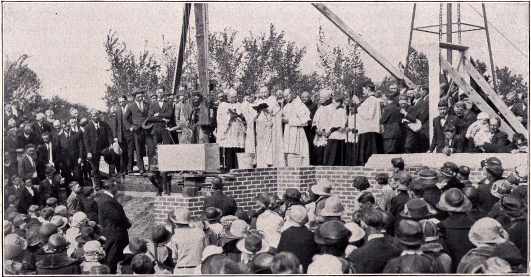
NEGenWeb Project
Church/Catholic
Franciscans

Laying of Cornerstone of New St. Joseph's Church at Platte Center.
erybody, owned and run by Joseph Russell, an eccentric old Englishman, who, nothwithstanding (sic) his many eccentricities and bluff manners, was a good neighbor and a valuable citizen. I have known of more than one hundred emigrants to be comfortably entertained at Russell's at one night, Californians, Colorado miners, Oregon farmers, ranchmen from off the plains and freighters to the mountains. Russell's House, in fact, became famous as a place of hospitality and fun. Nothing remains today to mark the spot that once was so full of life and animation, but a few locust and cottonwood trees set out by Mr. Russel whose body is now encased beneath the sod somewhere in Missouri. Directly south of Russell's ranch, the well known Shinn's rope ferry crossed the Platte river."
MAKING A SOD HOUSE
(Madison Star Mail, March 19, 1925.)
First, after plowing the sod about three inches thick, which was done with an ordinary breaking plow, it was necessary to cut it into the required length. As the walls were usually built three feet in width, a twelve inch sod, as we called it, had to be cut three feet in length. In laying the sod, open spaces were left, for doors and windows, the frames being built in as the walls went up. When the foundation was built, the order of laying the next course was reversed. This reversed process was repeated with every course till the walls reached the desired height. At the proper height spaces were left, as in the case of the door frames.
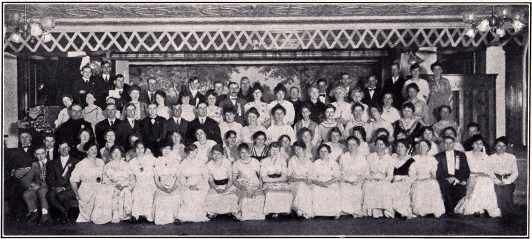
St. Bonaventure's Alumni Association, Columbus.
139
![]()
When the walls were up to about the thickness of a couple of sod above the frames, lintels were laid across, and the sod laid over them, continuing the wall right through the vacant space over the frames. This was necessary on account of the settling of the walls, continuing, perhaps, for years. Old rags or an old gunny bag was usually stuffed into the open space, and a portion of it removed as occasion required. When the walls were high enough, usually about six or seven feet, the gable ends were built up a few inches or a foot higher to prevent the dirt, as much as possible, from washing off by heavy rains. The roof was made almost flat. It was the general custom to trim down the surface of the walls with a sharp spade after they were up; but it was the rule with me to trim each course as I laid it, thus giving a better chance to keep them straight. We used to shave off the top surface of each course with a sharp hoe, filling in the cracks and openings between each sod. The walls being completed, we were now ready for the ridgepole, usually a tree from ten to fifteen inches through at the large end, and as near the same size, the whole length, as was possible to build it. Sometimes the bark was stripped off, for the wood lasted much longer that way, as well as having a neater and cleaner appearance. Raising the pole into a position was done by raising it upon skids, which necessitated the help of several of the neighbors. Skids were placed with one end resting on the edge of the wall, and the lower end extending away out on the ground. Some stood on top of the walls and pulled on the ropes, and others on the ground lifted up and pushed on the pole from below. Next came the rafters, poles from four to six inches through and placed about fifteen inches apart. Over these was laid willow brush; this was covered with a good quantity of hay, and finally dirt was piled on to the depth of six or eight inches. The plaster for the inside of the walls was composed of about one third part clay and two of sand. Two coats were usually put on. With the walls trimmed down smooth, and a little care in putting on the plaster, a smooth hard surface could be made and wall paper could be put on about as neatly as on the plastered walls of a frame building. Of course, it would not bear wetting, as it was often washed off by the rain coming through the roof. Many of the houses, however, were never plastered, and few had floors in them in the early days. The ground usually was the floor, and the door and window frames were hewn out of the scrubby timber that could be found anywhere.
DUGOUTS
In making a dugout, an excavation was dug into a bank; walls were then put up in front and also on the sloping banks at the sides and covered with a roof.
-A Pioneer Sod Carpenter.
FIRE GUARDS
"Often the accumulation of a life time of hard work is destroyed in a few minutes by a prairie fire caused by burning weeds, grass or cornstalks carried by the wind. A hurt of ten saves a man from trouble. There are three kinds of guards. We name them in the order as we find them prevalent; the plowed, the burned and the green strip.
As to the first, the trouble with too, many is that the plowing is not wide enough, some relying on a furrow or two, when at the very least, it should be a rod in width. The plowed guard should be turned over, and all weeds destroyed before the grass dries. Some are already cutting hay, and the following method may be useful to them. The writer has tried it and knows whereof he speaks. Select a spot in your meadow the highest and driest, and convenient for stacking. Mow off the stack yard and put the hay therefrom into a stack within; now make it wide enough around the "yard" to make a good sure guard; let this dry and then burn it. Make hay from another strip outside the burning, and cut and burn a second guard beyond that. If the grass springs up again on these guards, later along in the season, scatter dry hay over them and burn again while the adjacent grass is green. This method has several good points in its favor. It does not tear up and disfigure your meadow; the burning is done while the adjacent grass is green, and thus there is no risk to run. If properly done, you feel secure, which is a consolation worth remembering. Of course, this plan can be applied to the protection of fields and premises.
The third kind of guard is not much known to Nebraska, but we believe it would be good for permanent guards-as around an entire farm or premises. The plowed strips which heretofore had been used may be seeded down to blue grass, white clover or some other grass that will not burn. From present appearances it would seem as though the fall might be very dry; if so, we shall be sorry to have to chronicle so many destructive fires as there were in 1877, when Nebraska lost tens of thousands of dollars worth of valuable property in houses, granaries, barns, stacks of wheat, hay, etc., but the newspapers will abound in paragraphs of disaster unless more attention is paid to fire guards."--Columbus Journal, July 16, 1879.
140
![]()
AN EXCERPT FROM THE TRACY VALLEY CHRONICLE, 1870
(Handed in by Mrs. L. Dickinson.)
(Note: During the early days, when newspapers were less numerous than now, the people kept a record of events in the following manner. The paper reprinted below is headed "Chronicle 1," and is dated Jan. 27, 1870.)
"It came to pass that in the third year of the reign of Rutherford, surnamed Hayes, that certain of the young people of the land, even in Nebraska, arose and said, "Let us join us together and become as brothers and sisters, and let us meet on the sixth day of the week, and let us make merry with speeches and with reading and songs withal." And the saying pleased the people. And they chose them Thomas and other wise men, to make them laws by which they should be governed and by-laws by which they might be judged,
"And Joshua, the son of Henry of the tribe of Van, did they appoint to be their ruler. And William they chose for their scribe and Adam they chose to be keeper of the Treasury. And it was good in the sight of the people, and they were glad with exceeding great joy.
"And the young men beheld the maidens of the land, that they were fair to look upon, and they began to vie with each other to see who should find favor in the eyes of the maidens.
And Joshua, the son of Van, beheld the daughter of the tribe of Loman that she was very fair. Then spake Joshua within himself saying, "What hindered that she should become my wife." And he spake concerning things with the damsel and unto her parents and it pleased them. And it came to pass that in the 12th month, on the 8th day, he took her, and she became his wife and he dwelleth with his father unto this day. Robert, also of the tribe of Linn, took of the tribe of John, surnamed Daly; and in the twelfth month on the seventh day of the month, he took her, and she became his wife and the people said it was well.
"Then cometh the days of the great feast, even days of rejoicing, because God did show His mercy towards the children of men, and did send His only begotten Son, that the children of men might live and not die. In those days arose Robert, the son of Joseph, whose surname is Harper and spoke with his father saying: "Are not the daughters of Daniel comely, speak, I pray thee, to her, that I may take her and she become my wife." And Joseph hastened and journeyed to the land of the tribe of Daniel. And Daniel covenanted with Joseph and gave him his younger daughter to be his son Robert's wife. And Robert took his wife and his horses and his cattle and all his possessions, and departed from the land of Daniel and he abided there unto this day."--Humphrey Democrat.
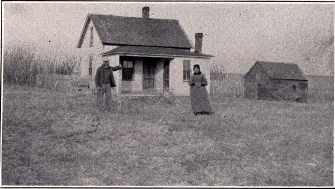
Mr. and Mrs. Casner Forthaus--Raeville.
RECOLLECTIONS OF EARLY LIFE IN TRACY VALLEY
(By Mrs. L. B. Leach.)
(Taken from the files of The Humphrey Democrat, December 18, 1903, through the courtesy of that newspaper.)
"It is difficult to write history for those to read, who helped make the history, as no two persons remember events exactly alike, but the following little sketch is as the writer remembers. The settlement of that part of Platte County known as Tracy Valley commenced in the spring of 1871. It has often been asked, whence the locality derived its name. There was at that time a man named Tracy living at Madison, which was then an ambitious town consisting of a store and post office combined, a blacksmith shop, a school house and two or three dwelling houses.
"Tradition has it that once, as Mr. Tracy was
141
![]()
|
Scenes on the John Purchal Farm, Platte Center |
Mr. and Mrs. Frank Fugger. |
Mr. and Mrs. Cornelius Heesacker. |
returning from a trip to Columbus, he found, upon arriving at the little creek that now bears his name, that it was swollen by recent rains to a raging torrent. Being a man of courage, he pulled off his boots, threw them across the creek and plunging in, succeeded in reaching the other side in safety, and from that day it has been Tracy Creek and the country through which it passes is called Tracy Valley.
PIONEER SETTLERS
"In the spring of 1871, there came E. T. Graham, Geo. Rollins, E. L. McGehee and the three Alderson brothers, and L. C. LaBarre. These all
142
![]()
settled in the Valley except E. T. Graham and Geo. Rollins, who located where is now Creston, but in those days was considered a part of the neighborhood.
"About the same time Walter Mead, C. O. Moore, Warren Potter and B. S. Dayton, all from New York, located in the Valley. In April Mrs. N. D. Leach and her son-in-law, E. E. Roscoe, came from Iowa. Steps were at once taken to secure a postoffice, and Mrs. L. D. Leach was appointed postmistress and to her was given the privilege of naming the postoffice. She called it HUMPHREY, that being the name of her old home in New York. In September of that year her daughter, Miss Roxy Leach, took as a homestead, the land now known as the Carr farm. In October L. B. Leach returned to Iowa to spend the winter, but came back in the following spring with his family. His brother, Rufus Leach and family came with him. In the fall of '72, Loman Porter came from New York and the following spring his son-in-law, Daniel Brooks. That same fall of '72 Nathaniel Crabtree and his sister Sarah came from Illinois, both taking homesteads, Mr. Crabtree's being the farm north of Humphrey now owned by Nels Pederson and it was he that planted the grove on that place. A man named Glassbrenner lived on the place, where Mr. Lohaus now resides and the farm next north belonged to a man named Miller.
FIRST SCHOOL DISTRICT
"Early in the season of '72, a school district was formed, No. 19, and Miss Roxy Leach taught the first term in a little sod house on her homestead. While teaching one day, she was interrupted by a visit from several Indians, who tried to sell her some small garments for her family. In the summer of '73, Miss Sarah Crabtree taught the school in a small dugout on the farm of L. D. Leach. In '72 a Sabbath school was organized at the home of C. E. Roscoe by Rev. J. M. Wilson, of the Presbyterian church, and sometime that year Rev. John Trine, of the M. E. church, began holding occasional services in the neighborhood.
PRECINCT ORGANIZATION
UNCLE
J. WALKER ELECTIONEERS
"A precinct organization comprising what is now Humphrey, Granville and Creston precincts was formed. The first election was held at Walter Mead's home and 28 votes were cast. At that time the people were more interested in the quality and quantity of the land each one possessed, the amount of crops raised, etc., than they were in politics. It was not until some time after this that the first candidate for office made his appearance in the person of John Walker, of Shell Creek, who was nominated for county commissioner. It is needless to say that his eloquence was so convincing of his eligibility for the office that he was elected. In the spring of '73 Mrs. N. D. Leach resigned her office of postmistress in favor of C. F. Roscoe, but in the fall of the same year Mr. Roscoe, wishing to return to Iowa, resigned and Mr. Mead was appointed, and the office was moved to his residence, where it remained until the building of the railroad made it necessary to change it to the present town of Humphrey. Mr. Mead also had a blacksmith shop, so his place became the central point in the community. The first school house was built in the spring of 1874, but before it could be used, it was destroyed by a prairie fire, which was a great misfortune; but later on another was built and the work went on. Christmas of 1872 was celebrated by young and old gathering at the home of Rufus Leach, the evening being spent in singing, acting characters, and tableaux, and in cheerful conversation, each one striving to put away from the memory, other Christmas nights when they were surrounded by more familiar faces.
PIONEER HARDSHIPS AND PLEASURES
"A few became dissatisfied and left the country, but most of those who came first remained and met with brave hearts the hardships which in one way or another always attend pioneer life. There were many things to live through. It was not pleasant to have long rains weaken the walls of the sod houses until they would collapse and all the household goods lie buried in dirt, or to find rattlesnakes creeping about the kitchen and sleeping rooms. One woman, on taking her dishpan from its nail found a snake quietly taking a nap. Neither was it agreeable to be housed up for days at a time with very little fuel and a blizzard raging outside. Perhaps the most disheartening occurrence was the grasshopper raid of 1874, but even that did not cause the people of Tracy Valley to give up and forsake their home, as many throughout the country did. If they had troubles, they also had their pleasures. The greatest harmony prevailed, they shared each others' joys and sorrows and obeyed the scriptural injunction to use hospitality without grudging. They kept all the holidays and made some extra. There was always some literary entertainment provided for their social gatherings and many things were done that helped make life pleasant. Neither were the women of the Valley burdened preparing elaborate toilet either for church or festive occasions. Everybody could command a clean calico and a sunbonnet and as
143
![]()
|
Old Humphrey Concert Band--(See page 71) |
|
Mr. and Mrs. Math Diederich. |
Mr. Thomas Ottis. |
Dr. W. M. Condon. |
for the men, boiled shirts were considered unfashionable. Thus they learned to prize each other at their true worth, and peace and happiness prevailed." (Editor's note: It may be interesting to some to know that the first house built on the site of Humphrey was a hotel built of sod standing on the present site of the Horton residence.) |
144
![]()
REMINISCENCES OF HON. T. D. ROBISON
EARLY SETTLERS IN
TRACY VALLEY
NORTH OF HUMPHREY.
Mr. T. D. Robison, who had been preceded by a friend, John Slater, before 1874, came with his brother James, to Madison county in the summer of 1876. He relates:
"I found quite a colony of New York people living in Tracy Valley. There was Walter Mead, who had the Humphrey postoffice just north of the Tracy Valley church; Byron Dayton, Charley Moore, Lavinus Leach, Rufus Leach, Riley Leach, Daniel T. Dickinson, John Van Blaricom, Loman Porter and Daniel Brooks. Ad and Tom Alderson were from Wisconsin, but had married sisters of my friend John Slater, and so it did not take me long to get acquainted with the people of Tracy Valley. They were very kind and hospitable and always made me welcome in their homes. John Alderson, John McGehee, Lute LeBarr and Ed Graham were from Wisconsin and Joseph Harper was from Minnesota. The New York and Wisconsin people came about 1873 or possibly earlier.
THE TRACY VALLEY CHURCH
"The Tracy Valley church lot was a part of the Byron Dayton homestead and the school house lot was the southwest corner of Mr. Harper's land that had been the preemption of Warren Potter. Where Humphrey now is, lived Writ. Tieskoetter and north of his homestead was an abandoned eighty that had been filed on by a man by the name of Horton. There were two Hortons--father and son. Billy Tieskoetter had the old man Horton's claim and I bought the son's relinquishment for ten dollars, and in August took it as a homestead. The old sod walls were standing and with poles and slough hay I fixed up a shack near the north line of my claim, so I could get water from the well of my friend, Leonard Widhalm, he having the claim joining mine on the north of his.
THE WIDHALM FAMILY
"The Widhalms could speak very little English and I could not Duetch spraken and our visiting was slow and laborous (sic) and difficult. One day I went for some eggs and I could not make the Mrs. understand. I made all kinds of noises and motions, but it was of no use. I started to go back home without them, when I heard a hen cackle. A happy thought struck me. I went to the hen's nest and taking an egg, I went back and, when I showed it to Mrs. Widhalm, she said "eier," and I said "egg," and after that I had no trouble in getting eggs. I first met Dick Olmer at Mr. Widhalm's when helping thresh. I think he came the same year I did.
"An old soldier by the name of Crabtree had a claim northeast of Widhalm's and he had bought of the Union Pacific, the eighty lying east of mine, for $4.50 per acre. He had made one payment and wanted me to take it off his hands, and if I had bought it, I would have had a good quarter section of land. Mr. Lohaus was then living north of Mr. Crabtree and Mr. Kosch north of Mr. Lohaus' claim.
AN EARLY SCHOOL MEETING
"The winter of 1876, I taught school in Stanton county, north of where Pilger now is, and in the summer of 1876 I worked on a farm for Henry A. Barnes, (a New York man), living three miles east of Madison, and I broke about twenty acres of my homestead with Mr. Barnes' horses. That spring, when on my homestead, I met a Mr. Costello. He was living west of where the brickyard now is, and he told me about a school meeting to be held at Mr. Selsor's. The Tracy Valley district had been divided, it formerly having been a whole township, half in Humphrey and half in Granville. This meeting was to elect officers and to locate the school house, where it would be near to them, and he wanted me to be at the meeting to see whether I could not place the school house in the center.
"I attended the meeting and after we had elected the officers the question came up about the location of the schoolhouse. I quickly made a motion to locate it near the center of the district. Costello seconded the motion and I insisted on the motion being put, for we were equally divided. A Mr. Quinn, Mr. Rowe, George Clark and Wm. Selsor on the one side and Leonard Widhalm, Billy Tieskoetter, Cosstello (sic) and myself for the center. I did some talking for the center of the district. I was a stranger to the most of them and Mr. Selsor got excited and wanted to know who I was, where I came from and how I had anything to say about it. When I said who I was and how I had a voice in the matter, he climbed over the table and came toward me. I thought it meant a scrap, but when he went to a trunk that was in the room, I was sure that he was after a gun. He opened the trunk and opened a blank book and said: "Come outside and I will assess you." He was the assessor for Granville township and so I paid taxes that year on a pony and watch, $1.75, my first taxes paid in Nebraska. When we came to vote on the proposition for the location of the school house, two of Mr. Clark's sisters, who had homesteads in the district, were brought in and that is the way that the school house came to
145
![]()
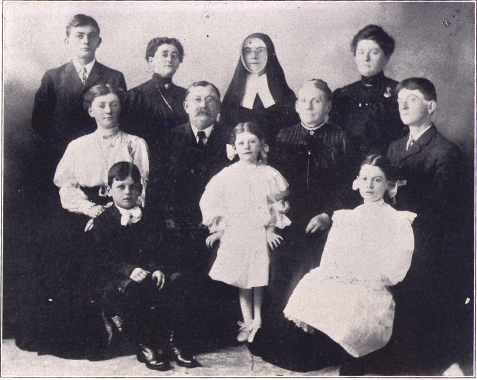
The Peter Kozlowski Family, Duncan. Sr. M. Concordia, O. S. F.
John Sokol, Duncan. |
Mr. and Mrs. John (Eliz. Ripp) Greisen. |
be across the road from Mr. Selsor's, now Henry Foltz's place.
(Then follow several paragraphs on early railroading in Nebraska, at which Mr. Robison helped for two years. After that the narrative continues):
"Every chance I would get I would visit my homestead for it was getting valuable, and I had to comply with the law, if I wanted to keep it. In February, 1881, I threw up my job and came to Humphrey. As soon as I could, I made final proof on my homestead and after I received my patent, I platted my first addition. Leopold Jaeggi had started a lumberyard for some Columbus firm (I don't remember the name). There was a great deal of building going on. Thomas Ottis was building his store; Wm. Eimers had his store built; Herman Tieskoetter was building his hotel; Dr. Norwood had a little drug store and I think
146
![]()
he was postmaster.
'1 spent part of 1881 and most of 1882 in New York State and was married in November, 1882. On the first day of January, 1883, my wife and I arrived in Humphrey and started housekeeping over Norwood's drug store, which was located where the electric light plant now is (1923).
EARLY HUMPHREY.
"In 1881 Mr. Thos. Ottis purchased from Wm. Tieskoetter forty acres, platted part of it and sold a number of building lots on Main street. All kinds of businesses were now well represented. Mr. Ottis, besides his store, had a "scoop house," where the farmers' elevator now is, and was buying grain; Wm. Eimers had a general store and a grain and lumber business; Wm. Ripp and Charley Sampont were buying grain and hogs for the Omaha Elevator Company. The depot was then on the west side of the track. Dr. Trout had built a drugstore north of Norwood's facing the depot and was living in the second story-he afterwards sold out to Herman Brothers and the building was moved over to Main Street, east of Herman Tieskoetter's hotel; Newell South had a hardware store and implement business; Joseph Gehr had the butcher shop; Charley Graham had a grocery store; Martini Bloedorn had an implement business and blacksmith shop and Mr. Arlt was the little wagonmaker; T. J. Sherwood had a livery barn and afterwards Joe Lachnit went into partnership with him; Jacob Steffes had built a hotel and a saloon; George Clark was writing insurance and doing a real estate business; Dan Drebert was postmaster. The public school was east of the depot and a Mr. Coleman was the teacher. Wm. Duesman had a furniture store east of Tieskoetter's hotel. William was single then and quite a favorite with the ladies! Wendell Eschelbacher and Jacob Ripp had a saloon and Eschelbacher was building a hardware store. The town was booming. People were coming in fast, land was getting valuable (from $10.00 to $15.00 per acre), corn was selling for about 30 cents a bushel, eggs were 10 cents a dozen, hogs about $3.00 a hundred, and a chicken sold for 15 cents, no matter what it weighed.
THE FIRST BANK.
"That summer Dan Drebert and Ira Briggs started the first banking business and the next year E. A. Stockslager came to town and bought out Drebert's interests and with Ira Briggs organized the Citizens' Bank. That winter Newel South's hardware store burned down, taking with it the new building of Jacob Steffes. The Catholics were building a church. It was a small edifice compared with the present one. It was built on the land Thomas Ottis bought from Wm. Tieskoetter and my understanding at the time was that Mr. Ottis donated the land to the church. F. H. Baker had a harness shop and was justice of the peace, F. M. Cookingham was working for Newell South and studying law-he was admitted to the bar and practiced law until he died.
THE FIRST BRICK YARD.
"In the spring, John Partsch, who lived in St. Mary's neighborhood, bought land of me and started a brick yard. He burned his first kiln of brick with sun flowers and corn stalks. I took the first payment on the land in brick for my residence that I started to build. Partsch soon sold out to Kaul and Fedderson. Kaul had a brick yard at Madison, and Peter Fedderson was a farmer living southwest of Madison. Fedderson later bought out Kaul and moved his brickyard southwest of town and there platted the land, where the brick yard now is
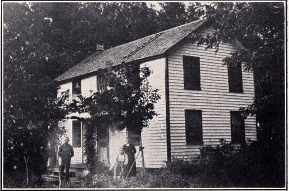
The Hubert Jaax Home, St. Andrew's, Polk County, Seberger Settlement, Where Franciscans Said Mass.
147
![]()
"That spring Henry Gietzen came and went into the hardware business with Wendel Eschelbacher. Joseph Linaberry moved in from Illinois and bought a five-room building that had stood just north of Tieskoetter's hotel; it had been a shoemaker shop. He moved the building on to a lot in my addition, and it was the first building on Robison's addition to the village of Humphrey.
"There are only a few of the old pioneers left. How soon will they be gone and forgotten? We had our grasshopper times, our droughts, our blizzards, our hopes and our discouragements. our joys and our sorrows but with it all we had an abiding faith in the future of our country.
"The story of the early settlements of the different localities--of the St. Bernard colony, the settlement of Stearns Prairie, of Shell Creek valley and of Burrows township would be of great interest to our readers. I hope some one in each locality will write it and you will publish it."--so far Judge T. D. Robison.
WILLIAM ADAM ALDERSON.
William Adam Alderson, son of Edmund and Sarah (Woodward) Alderson, was born at Hyland, Wisconsin, September 20, 1850. When 19 years of age, he worked out as a farm hand, and when of age, he came to settle on a 160-acre homestead, 1 1-2 miles east of Humphrey. Of this soil never before had a furrow been turned. He borrowed $16 to enter his land file and when the dues for filing had been paid, he had $5 on hand. But he worked steadily and especially by raising pure-bred stock. he earned a competency to spend the sunset of life at ease.
Mr. Alderson lived at first in a sod shanty. On October 27, 1874, he was united in marriage to Miss Elmira Slater, a sister of Mrs. H. A. Barnes. To this union six children were born: Verne A., Minnie Delia, and Mabel Frances, who have preceded their father in death, and Oliver R., and Rose of Humphrey, and Wm. Ad. Jr. of Madison, and two brothers, J. M. and P. F. Alderson, of Madison, one sister, Mrs. R. F. Jones and three half brothers. Mr. Alderson died at the Omaha Swedish Hospital after an operation for cancer of the stomach, September 14, 1923, and was interred at the Creston cemetery. He had retired from the farm in 1911, and moved to Fremont, but returned to Humphrey in 1912, residing in their large house in the south part of the town.
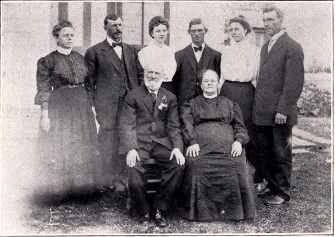
The John Jaax Family, St. Andrew's, Polk Co.
Mr. Alderson was a good man, esteemed by all, kind, sympathetic, encouraging, of good judgment and firm convictions. His was a life of strenuous labor and honest work and also of pure unselfishness, for he cared more for the happiness of others than for the satisfying of his own desires. He left the world better for having lived in it.
GEORGE FRANCIS TRAIN
George Francis Train, a wizard of finance, was once a citizen of Columbus and had great ideas for the future of the capital or Platte county. He was a native of Boston, where his birth occurred in the year 1830. When residing in New Orleans in 1834, his father, mother and three sisters were carried away during the terrible epidemic of yellow fever, George Francis returned to the old homestead near Waltham, Massachusetts, to finish his education. At the age of nineteen he established at Liverpool, England, the "Train Shipping House" and at
148
![]()
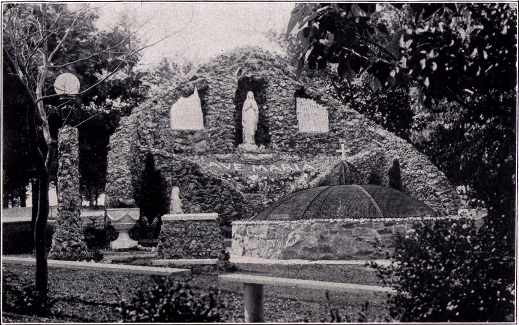
The Memorial Lourdes Grotto at Tarnov.
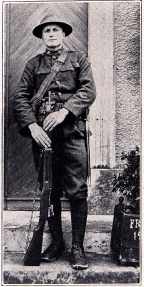
Andrew J. Jarosz, Originator of the Grotto.
the age of twenty-one years was one of the main stockholders in the Diamond Line "Liverpool & New York Sailing Packet Company". In 1853 he organized the Shipping Firm of George F. Train & Co. at Melbourne, Australia, introduced the Chamber of Commerce and the Board of Trade and built a Telegraph line and a railroad. In 1859 he built the first street railway in Europe according to American patent and piled up a fortune of several millions. Train was now lionized by the whole civilized world, because of his wonderful financial ability. Besides, G. F. Train was one of the finest orators of his day. Returning to the United States! in 1862, he held at New York the famous three days debate with C. M. Clay on the Civil War and the Slave issues. The man of the hour, Mr. Train now launched on his War Policy Tour in support of the Union Government and was sought by the assassin at Dayton, Ohio; Alton, Illinois; and Davenport, Iowa, and was ordered out of Missouri by Major General Curtis.
Train next turned his attention to Nebraska and financed the Union Pacific railroad, the first transcontinental line, and was present on December 2, 1863, to dig the first spade for the gigantic undertaking, of which Abe Lincoln was one of the patrons. After Train succeeded in having the bill authorizing it pass Congress, he organized the Credit Mobilier with a capital of ten million dollars, to build the railroad. He organized a similar second organization to build cities along the right of way of the U. P. H. H. from Missouri to Salt Lake City. Mr. Train owned 500 acres in Omaha purchased at $175 per acre. Being very much interested in Columbus, which he believed to be near the geographical center of the United States and of the world, he laid out lots in the Capital Addition near where the Union Pacific Depot now is,
149
![]()
bought up the rival town of Cleveland, 2 or 3 miles north of Columbus, moved the hotel to Columbus and named it "The Credit Mobilier Hotel". Here he reserved one room for himself, another for the President of the United States. But as he never offered his lots for sale, the boomers that had flocked to Columbus were disappointed and the boom failed.
At Omaha he purchased a lot for $5,000 and had a big three-story hotel with 120 rooms erected in 60 days at a cost of sixty thousand dollars and rented it immediately for $12,000 per year. O. F. Train also published a book: "My Life in Many Lands". Unable to realize all the projects that filled his busy brain, this magic wizard of a financier lived many years in a cheap New York hotel, speaking only to children. Arrested for publishing an obscene book, he was set free as being insane. He died January 18, 1904, with $30,000,000 property at Omaha in litigation.
REV. JOHN CALVIN EVANS
(BY W. S. E.)
Evans, who passed away in Columbus on the 21st of April, 1914, brought a colony to that city in the fall of 1879 and was long a factor in the moral development and growth of the community. His birth occurred in Connoquenessing township, Butler county, Pennsylvania, on the 22d of October, 1838, his parents being William Valentine and Rachel (Hammel) Evans, who were married at Faulkstown, Ohio, October 2, 1834. This branch of the Evans family are direct descendants of Evan Evans, who came from Montgomeryshire, Wales, in 1722 and on November 17th of that year settled on a farm on White Clay Creek, Chester county, Pennsylvania. The place is still in the possession of members of the family. A complete record of those of the name will be found in the book entitled "History of the Evans Family," which was finished by Rev. John C. Evans a few months before his death in 1914.
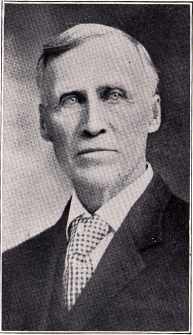
Rev. John C. Evans.
John C. Evans acquired his education in the public schools of Butler county and those of Tarentum in Allegheny county, Pennsylvania. Subsequently he entered Franklin College, now the University of Ohio, at Athens, Ohio, being graduated from that institution in 1861. The same year he volunteered for service in the Union army, but was rejected on account of physical disability. He was drawn in the first draft in Allegheny county, Pennsylvania, and was again rejected because of organic heart disease. Preparing for the ministry, he was graduated from the Allegheny Theological Seminary of the United Presbyterian church in 1867 and during the next twelve years acted as pastor of churches in Neaver county, Pennsylvania, presiding over Four Mile Church and the Remington and Oakland congregations.
THE COLONIZER
In 1879, Rev. Evans brought a party of over sixty persons from the neighborhood of Pittsburgh, Pennsylvania, to Columbus, Nebraska, the colony arriving here on the 17th of October. With this party came William Cornelius and family, the Dodds family, James Boggs and family and the McKims, and the following year many others were added from the same locality, including Dr. C. D. Evans. Many of these are still residents of Platte county and are numbered among its most substantial citizens. From 1879 until 1883 Rev. Evans was engaged in home mission work for the United Presbyterian church in Nebraska and during the remainder of his life was a clergyman of the Congregational church. About 1883 he removed with his family to Buffalo county, Nebraska, where he resided until 1910, when he went to southern California on account of failing health. In the spring of 1914 he returned to Columbus and here passed away on April 21st, being buried in the Columbus cemetery beside his wife, Mrs. Nancy A. Evans, whose demise occurred in 1903.
On the 23d of December, 1862, in Tarentum, Allegheny county, Pennsylvania, Rev. Evans was united in marriage to Miss Nancy A. Gilliford, a daughter of Robert and Nancy Gilliford. She was educated in the common schools
150
![]()
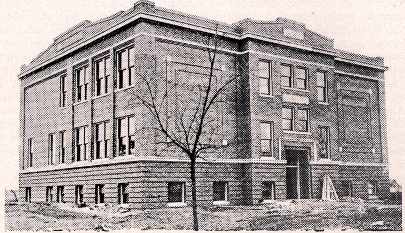
Present Humphrey High School.
of Allegheny county, Pennsylvania, and the Ladies' Seminary of Juniata county, Pennsylvania, at Academia, and taught school in Tarentum, Pennsylvania. Her family were early pioneers of the Keystone state and her ancestors served in the Continental army during the Revolutionary war. To Rev. Evans and his wife were born the following children: William S., Robert O., Charles V., Edgar G., Henry C., Nancy K. and Rachel H.
In his political views Rev. Evans was a republican, exercising his right of franchise in support of the men and measures of that party.
His life was devoted to the service of the Master and his zealous, consecrated labors were not denied the full harvest nor the aftermath.
REV. JOHN RICHARD WILLIAM NEUMAERKER, D. D.
Rev. J. R. Neumaerker, for years pastor of the Evangelical Lutheran Church at Columbus, was born November 6, 1844, at Sprottay, in Saxe-Weimar, Germany. He attended school at Blankenheim; was also instructed privately by his father, the Rev. William Neumaerker; attended the gymnasium at Weimar for five years,
Evangelical Lutheran Church, Columbus |
Mr. and Mrs. Joe. Froemel. |
151
![]()
graduating in 1865; pursued a three years course of theology at the Jena and Halle universities, graduating in 1868; was assistant professor at the gymnasium at Meiningen, and tutor of Prince Karl of Hesse-Philippsthal, field deacon for the Red Cross in the German-French war; vicar of the court church at Weimar and professor at the gymnasium. His next position was that of pastor in the Grandduchy of Luxemburg till 1882, then pastor at Mihla, Saxony-Weimar. In spring 1885, he received a call to the pastorate at Barada, Richardson county, Nebraska; thereupon he served as pastor in St. Joseph's, Missouri, 1894-1899. In the latter year he was called to the pastorate of the Lutheran Evangelical Church at Columbus, Nebraska, where he remained until his demise.
Rev. Neumaerker had received the honorary title of Doctor of Divinity from Midland College; of Atchison, Kansas, and served for eight years as president of the German Evangelical Lutheran Synod of Nebraska.
In 1875, at Lissa, Posen, Rev. R. Neumaerker was wedded to Miss Elizabeth Roth, daughter of Rev. Pastor Carl August Roth, of Sonnenburg province of Brandenburg, Prussia. Their union was blessed with three children, William R., now physician at Columbus; John and Emmy, (Mrs. A. C. Plarow).
Rev. R. Neumaerker died March 31, 1928, at Columbus.
REV. HERMAN MIESSLER
Rev. Herman Miessler was a native of Michigan, where he was born in Isabella county in the year 1861. His father Gustav had labored as a missionary among the Chippewa Indians, till 1869. After that he studied medicine at the Hahnemann College, Chicago, Illinois. Herman obtained his common school education in Michigan, attended school in Chicago, graduated 1880 from Concordia College, Fort Wayne, Indiana, and finished his course of theology at Concordia Seminary at St. Louis, Missouri. When he came to Columbus to take over the Lutheran congregation, it numbered ten families. Two missions were also in his charge till they became self-supporting. In 1915 the Columbus parish numbered 100 families. On October 5, 1884, he was united in marriage to Miss Clara Wirmb, born in South Africa, where her father had been a missionary. Rev. Miessler, who was very prominent at Columbus for several decades of years, died about two years ago. His wife followed him in death in 1930.
LEANDER GERRARD, 1837--MARCH 3, 1913
On August 31, 1837, there was born to Mr. and Mrs. Joseph (Adeline Allen) Gerrard, of New Bedford, Massachusetts, a boy, whom they named Leander. The parents, in 1838, removed to Monroe, Platte county, Nebraska, and there Joseph engaged in farming until his death, in 1870. Mrs. Adeline Gerrard passed away in 1896. Leander received his education in Illinois and then he began his career as clerk in a clothing store. In 1855 he came to Des Moines, in 1856 to Omaha, to study law. He formed a partnership in real estate with Mr. Newton and helped to found the city of Fremont, Nebraska. In 1857, Leander removed to Monroe county and lent his aid to organize and to lay out the town of Monroe. Subsequently Monroe became part of Platte county. Leander traded with the Pawnee Indians at the reservation at Genoa, 1860-'66, and also conducted a trading post and did freighting between Fort Kearney and Monroe.
In 1867, L. Gerrard went to Columbus and formed the law firm of Gerrard and Reed. He established a private bank, which, in 1875, was merged into the Columbus State Bank. L. Gerrard practiced law and did real estate business. For many years he was a member of the Whitmoyer, Gerrard and Post law firm. He became one of the most influential and prominent citizens of Platte county.
On May 31, 1870, Gerrard married Elizabeth Caroline Weaver, coming from Columbus, Ohio, of German parents. To their union were born four children: Clarence L., the inventor of a flour bleacher; Ernest A., Phoebe and Grace.
In 1858, L. Gerrard helped to organize the Republican party in Nebraska, and was chairman of the first Republican state convention at Plattsmouth. He served as a member of the first state legislature. In 1870 and 1871, as state senator, he was the author of the Herd law, protecting agricultural interests. He refused the office of United States district attorney tendered him by President U. S. Grant. "He was faultless in honor, fearless in conduct and stainless in reputation and highly respected."
EDGAR HOWARD--
"THE MOST UNIVERSALLY LIKED CONGRESSMAN"
One of the best known figures, not only in Platte county and Nebraska, but in the United States, is Edgar Howard, who for long years has represented the Third Nebraska district in the United States congress.
He was born at Osceola, Iowa, September 16, 1858. His parents were James Dakin and Martha (Daniell) Howard. His primary education was received in the public schools. He attended the Western Iowa Collegiate Institute and the Iowa College of Law, later merged with Drake University.
At the age of sixteen he became a "printer's devil" in the office of the Glenwood (Iowa) Opinion. Following his graduation in the art
152
![]()
preservative, he became a tramp printer and writer, visiting all the great American cities in that capacity. His latest employment prior to engaging in the newspaper business on his own account was in Dayton, Ohio, where he became city editor of the Dayton Daily Herald. His first newspaper venture was the Papillion (Neb.) Times, which commanded his attention from 1883 to 1887. His partner in ownership of The Times was Hon. George Magney, now residing in Omaha. Leaving Papillion, he founded the Dundy Democrat, at Benkelman, Nebraska, had a hectic career of three years in that then zone of coyotes, cactus and homesteaders, returning to his old newspaper love at Papillion in 1889, when he again purchased the Papillion Times, owning and editing that sheet until November, 1900, when he purchased the Columbus Weekly Telegram (now The Daily Telegram), with which publication he is still connected.
November 11, 1884, he was united in marriage with Elizabeth Paisley Burtch, daughter of one of the pioneer families in Bellevue, Nebraska. Their children are: Findley Burtch Howard, now serving as customs adviser to the Republic of Guatemala; Mary (Howard) Rex, wife of Mr. Harry Rex, of Creston, Iowa, and Helen (Howard) Coen, wife of Mr. Clarence Coen, of Creston, Iowa.
His first official position was that of Sarpy county representative in the Nebraska House of Representatives. In the session in which he served, the House was composed of 72 republicans, 22 populists, 5 demo-pops (fusionists) and one lone democrat, Mr. Howard being that lonesome one. Two years later he was elected Probate Judge of Sarpy county, Nebraska, and reelected two years later. In 1900 he was the democratic nominee for congress in the Omaha district, but failed to win a certificate of election. In 1916 he was elected lieutenant-governor of Nebraska, serving one term. In 1922 he was the democratic nominee for congress in the Third district, and was elected by a small plurality over two opponents. He has been elected to that office five successive times, his majority in the last (1930) election rising above 29,000. Always Mr. Howard has played the part of loyalty to William J. Bryan and to his governmental principles. In 1891 he served as private sectetary (sic) to Mr. Bryan, who had been elected to represent the Omaha district in the House of Representatives at Washington.
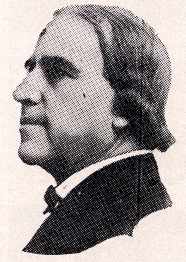
Congressman Edgar Howard.
The greatest of all news magazines, "Time", recently devoted a full page to our Third district congressman, in part as follows:
"Edgar Howard is the most entertaining of representatives, but never a clown. He is a cogent contributor to the work of the committees on Public Lands, World War Veterans Legislation, Coinage and Measures, and Indian Affairs. He calls himself a 'free' democrat, but is seldom not 'regular.' He is friendly with the powerful republican leaders, whom he humorously castigates. He is one of the last of the old-school democratic statesmen.
"Regarding foreign affairs Mr. Howard is opposed to any and all foreign entanglements.
"In appearance he is squarely built, bob-haired-a mild-mannered gentleman, resembling a combination of William J. Bryan and Benjamin Franklin. He wears the traditional frock coat and wide-brimmed Quaker black hat (in summer a white hat and suit
"He is an able writer, and some of his writings have become classics, such as his 'Ox-Blood Rose', 'To My Dog', 'The Voice of a Flower', 'A Nebraska 'Sunset', and 'The Smoke Sign on the Sky'. (See also The Old Family Doctor in this volume, appearing in the write-up of Saint Mary's hospital).
"Mr. Howard is, moreover, an orator of note. He speaks with a voice almost clerical, with a slight drawl, but not a monotone. He can invest the simplest sentences with an air of profundity, and yet can fashion pleasing verbal bouquets.
"His parents were Quakers, but he is an Episcopalian. His fraternal affiliations are the Odd Fellows, Knights of Pythias, Rotary, York and Scottish Masonic rites and Ancient Order of the Mystic Shrine.
"He is a natural sport. He never attends Sunday baseball games or horse races, but will
153
![]()
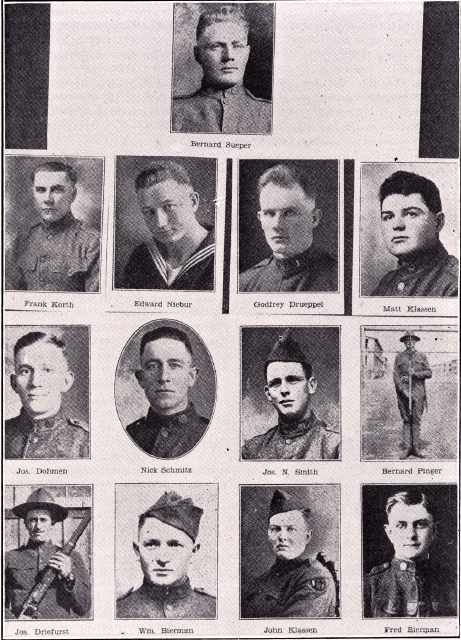
World War Soldier Boys from St. Bernard Parish.
fight to give others a chance to enjoy Sunday sports. He is bitterly opposed to all Sunday blue laws.
"Mr. Howard never touches intoxicating liquors during the day hours, but is still loyal to the custom of his Virginia forefathers in taking his good-night toddy (whenever he can get it).
"Impartial House observers rate Edgar Howard as a fine example of what congressman were in the last century, plus a pointed ubiquitous sense of humor. An adept at floor strategy, he is able to transcend the House rules by his witty, original methods, thus becoming an insidious protagonist of minority measures. He is perhaps the greatest character in the House, and the most universally liked congressman."
Edgar Howard frankly says that he is not ashamed to admit that he is a hero worshipper. He worships at the memory shrine of three governmental saints--Thomas Jefferson, Abraham Lincoln and William J. Bryan. Those great statesmen preached the gospel of the American farm, regarding it as the best stone in the foundation upon which rests the house of our
154
![]()
republic, and the best efforts of Mr. Howard in his public service are always in behalf of what he terms a "square deal" for agriculture. He is devoted to the welfare of the surviving veterans of all American wars, and to the remnant of the American Indians, particularly those now living in Nebraska.
At Columbus, Nebraska, Mr. and Mrs. Howard live in the Evans hotel. In the national capital their home is in the George Washington Inn.
THE FIRST AUTO IN COLUMBUS
"August 10, 1900, Dr. Greer comes out upon the streets with his latest fad, the locomobile. It is then that you find a great many necks stretching out to see. It is the one the doctor purchased recently in Chicago and he uses it nearly all the time in his practice. It has many advantages over the horse; it is speedier. It's always ready, doesn't get scared at the cars and never runs away. It works over any kind of roads and through any soil, though, of course, the better the roads, the easier it works. The speed of twenty-five miles can be attained on level good roads, though the doctor says that twelve to fifteen miles an hour is as fast as any one would care to ride. When standing, the locomobile looks very much like an ordinary covered wagon, except for the pneumatic tires; but it also gives one the impression that the horse had just run away with the shafts."--Humphrey Democrat.
THE FIRST TELEPHONE AT COLUMBUS
As far we could ascertain, the first telephone at Columbus was installed at the railroad station in the year 1878. Other persons were to install one, also, provided the first one proved to be a success.
MR. MICHAEL MAHER,
PLATTE CENTER
HIS YOUTH
Michael Maher, one of the pioneers of Platte county, was born in 1831 in county Tipperary, Ireland, near the village of Thurles. His boyhood days were clouded with the memories of revolution and persecution. He was but a youth when his father, Edmund A. Maher, was exiled into Australia as a political prisoner. Michael and his brother, Thomas, accompanied their father into exile and remained in Australia for seven years, where they engaged in gold mining. In those days of exile, young Michael and his brother used to often dream of far-away lands, where freedom beckoned and where possible treasure existed.
RETURN FROM AUSTRALIA TO ERIN
Aftr (sic) serving the seven years imposed upon him, Edmund A. Maher and his two sons returned to Ireland, hoping to see the clouds of political oppression scattered and a dawn of freedom coming for his native land. They were greatly disappointed and despairing of the hope that Ireland would ever be free, the family came to America, settling in Rock county, Wisconsin. It was here that Michael Maher married Catherine Gilfoyle, a young girl, whom he had known in his earliest youth in Thurles.
TO THE. "LAND OF GOLD"
While in Wisconsin, Mr. Maher became interested in farming, but after the birth of three children, Edward, John and Thomas, he felt that his ambitions were being stifled in so settled a country. He dreamed of the west and visualized the gold mines, not of Australia, but of California. He and his young wife, with their babies, and his 'brother Thomas, equipped a covered wagon, the schooner of the prairies, and started out to grasp the vision of larger opportunity that led every pioneer west. Reaching Fort Kearney, Nebraska, they were informed by government troops that it was exceedingly dangerous to proceed farther, because of hostile Indians. They were told that the troops forbade families undertaking the journey unless in bands of one hundred wagons. At first this was discouraging news to the family, who were longing to end their travels and settle. Then they decided to remain, where fate had stopped them.
SETTLES ON SHELL CREEK
They saw Shell Creek and its verdant valley and Catherine Gilfoyle Maher thought it beautiful enough to call it home. She wrote to her sister that winter, "The climate is beautiful and healthful and the black soil is ten to fifteen feet deep in our valley. We are going to have a school built in March." The family settled here in Platte county and helped in the developing of the community. After a time, others came to join them and the family circle widened to include the comrades of exile, Thomas and the father, Edmund A. and his wife. Nellie Maher and Blake Maher, the younger members of the family, were born in Platte county.
THE PROGRESSIVE FARMER OBTAINS POLITICAL HONORS
Mr. Maher took the keenest interest in the growth of the county and in its prosperity and efficient government. During the early years he wrote articles for eastern papers and magazines about the opportunity offered in Nebraska and by his efforts induced many Germans and Irish to settle in Platte county. Later he served as County Commissioner, accepting the office for three terms. nine years. and in 1889-'90 he
155
![]()
|
|||